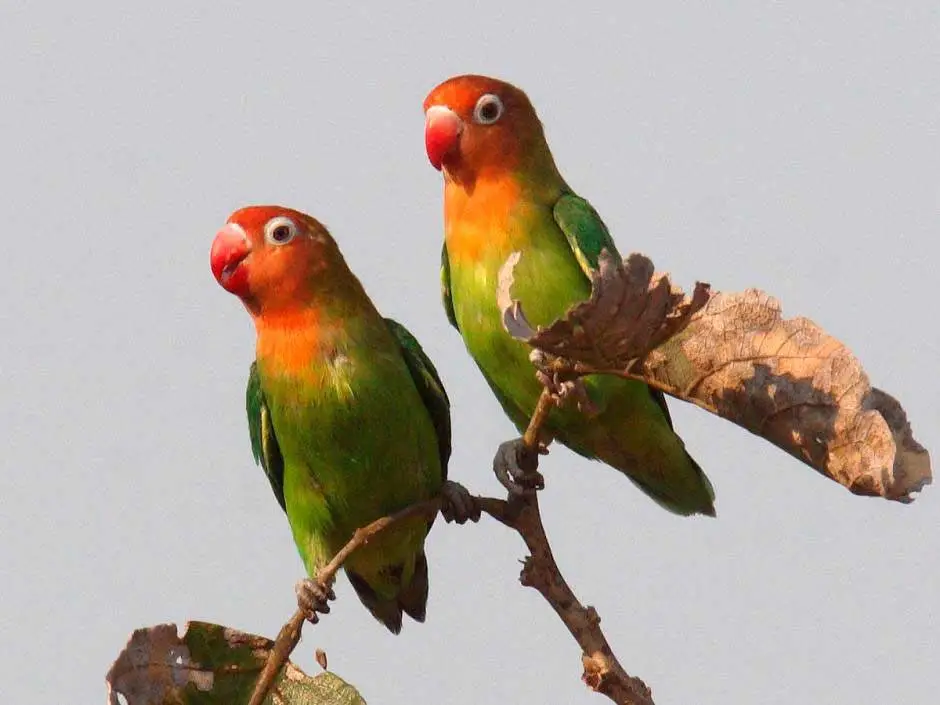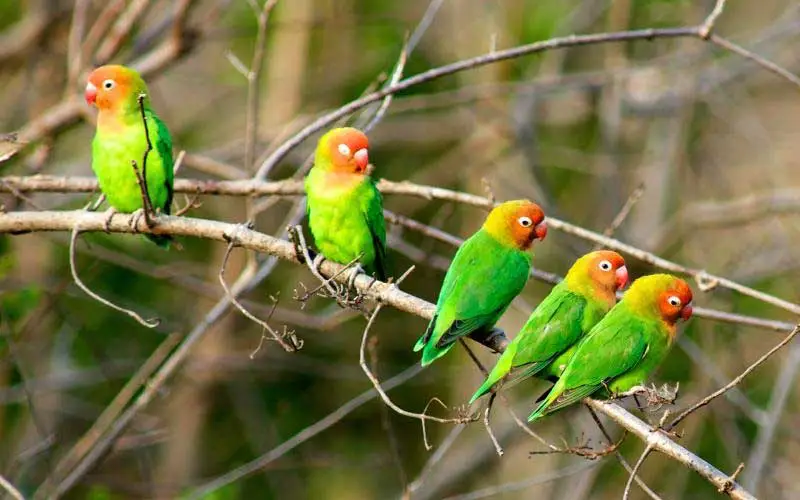
The Lilian’s lovebird (scientific name is Agapornis lilianae), commonly known as the Nyasa lovebird, is a small yet vibrant parrot species found mainly in mainland Africa. These little wonders boast an olive green hood, a salmon pink upper breast with a varying black wash, a blue rump, and a striking white eye ring. Their dark red-brown eyes add to their charm, making them an attractive sight for bird enthusiasts.
The Nine Species of Lovebirds
Lilian’s lovebirds belong to the genus Agapornis, which comprises nine unique species. They are part of the family Psittaculidae and are considered one of the smaller parrot species. Their colorful plumage and affectionate behavior make them popular among bird lovers and breeders worldwide. They are:
- Peach-faced Lovebird (Agapornis roseicollis)
- Fischer’s Lovebird (Agapornis fischeri)
- Yellow-collared Lovebird (Agapornis personatus)
- Lilian’s Lovebird (Agapornis lilianae)
- Black-cheeked Lovebird (Agapornis nigrigenis)
- Red-headed Lovebird (Agapornis pullarius)
- Madagascar Lovebird (Agapornis canus)
- Abyssinian Lovebird (Agapornis taranta)
- Black-winged Lovebird (Agapornis swindernianus)

Habitat and Distribution
Lilian’s lovebirds are primarily found in the Liwonde National Park, located in Malawi. However, they also inhabit other national parks and surrounding forests within Zambia, Mozambique, and Zimbabwe. These charming birds thrive in mopane trees and miombo woodlands, where they live among other species of birds.
Sadly, the Lilian’s lovebird is facing loss of habitat due to increasing human population growth, agriculture, and deforestation. The extent of habitat loss is alarming, as these birds are now restricted to fragmented miombo forest reserves with the highest human population density in the region.
Feeding habits
Lilian’s lovebirds have a diet primarily consisting of grass seeds and wild rice, which they forage from the surrounding environment. These birds are known to be opportunistic feeders, meaning they’ll also feed on fruits, berries, and occasionally insects when available. Fig trees are a valuable source of energy for many bird species, including Lilian’s lovebird.
Interestingly, while foraging, Lilian’s lovebirds often interact with other bird species, including weavers, sparrows, and queleas. These interactions highlight the importance of preserving not just the lovebirds’ habitat, but also the ecosystems they share with other kind of species.
Breeding and Nesting
Breeding Season and Breeding Habitats
The breeding season for Lilian’s lovebirds usually occurs between January and March, though it may vary depending on local weather conditions. Lovebirds fall victims to many challenges during this season, but they remain resilient in their efforts to continue their species’ legacy.
Roofed Nests and Tree Crevices
A Lilian’s lovebird builds roofed nests using grass and other plant materials, typically within tree crevices. Interestingly, they may occasionally use the abandoned nests of other birds as well. The female lays four to six eggs, which hatch after an incubation period of about 22 days.
Courtship feeding is a fascinating aspect of Lilian’s lovebird behavior, where one partner, typically the male, offers food to the other, usually the female, as a part of their mating ritual. This unique display of affection not only strengthens the bond between the lovebirds but also showcases the male’s ability to provide for the female and their future offspring. By engaging in courtship feeding, the couple establishes a foundation of trust and cooperation that is vital for successful reproduction and raising healthy chicks. In some species, this ritual can even involve intricate dances, making it a delightful spectacle for birdwatchers and nature enthusiasts alike.

Conservation Challenges
Lilian’s Lovebird Poisoning
One of the major threats to the Nyasa lovebird population is poisoning. Farmers often use pesticides to protect their crops, but these chemicals can unintentionally poison the lovebirds as they forage for food. Efforts are being made to raise awareness among farmers and reduce the use of harmful chemicals to protect these birds.
International Cage Bird Trade of Agapornis lilianae
Another significant threat to Lilian’s love is the international cage bird trade. These small parrots are sought after for their beauty and affectionate nature, leading to their capture and sale in the pet trade. Sadly, many lovebirds fall victim to this illegal activity, further endangering their already fragile population.
You can find updated information about the Lilian’s lovebird in the CITES trade database.
Comparing Lilian’s Lovebird with Fischer’s Lovebird
Although Lilian’s lovebirds share many characteristics with Fischer’s lovebirds, they can be distinguished by their varying colors and markings. Both species have the iconic white eye ring, but Fischer’s lovebirds have a more vibrant orange face and a greenish-yellow chest.
While Fischer’s lovebirds are currently listed as Near Threatened, these lovebirds are considered Vulnerable due to their shrinking habitat and the threats they face from human activities. Conservation efforts must focus on protecting the remaining habitat and addressing the challenges posed by habitat loss, poisoning, and illegal trade.
The Role of National Parks and Forest Reserves
National parks and forest reserves play a crucial role in safeguarding the remaining habitat of the Lilian’s lovebird. By protecting these critical ecosystems, we can ensure the survival of not only the lovebirds but also the numerous other species that share their home.
In addition to providing a safe haven for the Lilian’s lovebird, national parks and forest support other species, including larger mammals such as elephants, antelopes, and leopards. By conserving these ecosystems, we can help maintain the delicate balance of nature and promote biodiversity.

The Struggles of Breeders Worldwide
Breeding of a Lilian’s lovebird in captivity is no easy task. Breeders worldwide struggle with the challenges of providing the ideal environmentv (main health concern), diet (especially grass seeds and wild rice), and care for these birds. Additionally, their vulnerability in the wild makes obtaining healthy breeding stock difficult and raises ethical concerns.
Despite the challenges, captive breeding programs can play a vital role in the conservation of Lilian’s lovebirds. By establishing healthy, sustainable populations in captivity, we can reduce the pressure on wild populations and contribute to their preservation.
Conclusion
The world of Lilian’s lovebird Agapornis lilianae, or the Nyasa lovebird, is a fascinating one filled with vibrant colors, unique behaviors, and undeniable charm. However, these small parrots face numerous threats, including habitat loss, poisoning, and the worldwide trade of cage birds. Found primarily in places like Liwonde National Park, being separated from the others, loneliness turns out to be the most significant health concern they encounter. By supporting conservation efforts and raising awareness of the challenges these birds face, we can help ensure the survival of Agapornis lilianae and the rich ecosystems they inhabit.
